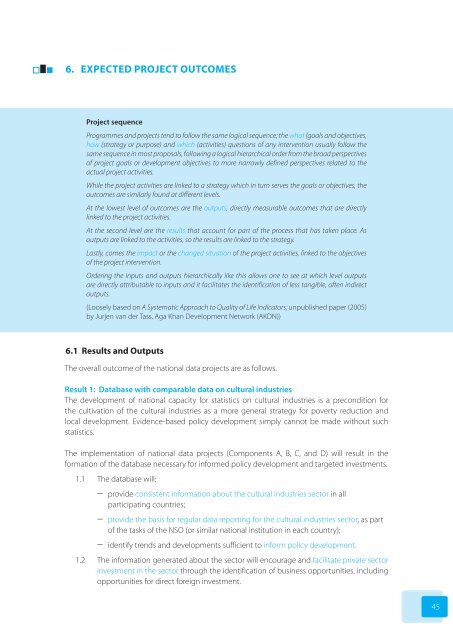Statistics on Cultural Industries - International Trade Centre
Statistics on Cultural Industries - International Trade Centre
Statistics on Cultural Industries - International Trade Centre
- No tags were found...
You also want an ePaper? Increase the reach of your titles
YUMPU automatically turns print PDFs into web optimized ePapers that Google loves.
6. Expected Project OutcomesProject sequenceProgrammes and projects tend to follow the same logical sequence; the what (goals and objectives,how (strategy or purpose) and which (activities) questi<strong>on</strong>s of any interventi<strong>on</strong> usually follow thesame sequence in most proposals, following a logical hierarchical order from the broad perspectivesof project goals or development objectives to more narrowly defined perspectives related to theactual project activities.While the project activities are linked to a strategy which in turn serves the goals or objectives, theoutcomes are similarly found at different levels.At the lowest level of outcomes are the outputs, directly measurable outcomes that are directlylinked to the project activities.At the sec<strong>on</strong>d level are the results that account for part of the process that has taken place. Asoutputs are linked to the activities, so the results are linked to the strategy.Lastly, comes the impact or the changed situati<strong>on</strong> of the project activities, linked to the objectivesof the project interventi<strong>on</strong>.Ordering the inputs and outputs hierarchically like this allows <strong>on</strong>e to see at which level outputsare directly attributable to inputs and it facilitates the identificati<strong>on</strong> of less tangible, often indirectoutputs.(Loosely based <strong>on</strong> A Systematic Approach to Quality of Life Indicators; unpublished paper (2005)by Jurjen van der Tass, Aga Khan Development Network (AKDN))6.1 Results and OutputsThe overall outcome of the nati<strong>on</strong>al data projects are as follows.Result 1: Database with comparable data <strong>on</strong> cultural industriesThe development of nati<strong>on</strong>al capacity for statistics <strong>on</strong> cultural industries is a prec<strong>on</strong>diti<strong>on</strong> forthe cultivati<strong>on</strong> of the cultural industries as a more general strategy for poverty reducti<strong>on</strong> andlocal development. Evidence-based policy development simply cannot be made without suchstatistics.The implementati<strong>on</strong> of nati<strong>on</strong>al data projects (Comp<strong>on</strong>ents A, B, C, and D) will result in theformati<strong>on</strong> of the database necessary for informed policy development and targeted investments.1.1 The database will:–––provide c<strong>on</strong>sistent informati<strong>on</strong> about the cultural industries sector in allparticipating countries;provide the basis for regular data reporting for the cultural industries sector, as partof the tasks of the NSO (or similar nati<strong>on</strong>al instituti<strong>on</strong> in each country);identify trends and developments sufficient to inform policy development.1.2 The informati<strong>on</strong> generated about the sector will encourage and facilitate private sectorinvestment in the sector through the identificati<strong>on</strong> of business opportunities, includingopportunities for direct foreign investment.45
















